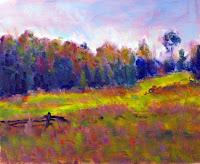It has been difficult to forget the large painting on my easel. Christmas Eve, Day, and the Day after with a room full of guests could not detract the critic from looking over everyone's shoulder at the start of a snow scene taken from the small done on site. The agony of being unable to attend to errors, omissions, large canvas alterations etc. So now that I have some time, I already have a list and a sense of direction to pursue.
Coffee up, put on the play list, and get in there to squeeze out. Scrape off the dried up pigment. Lets see, squeeze out Cobalt Blue, Cadmium Yellow Middle, Alizarin, Veridian, and Titanium White.
Restarting "At the Edge of It", 36x48, Oil on Canvas
There are more piles of paint than those you say. True. The paint mentioned is the foundation for the painting and are squeezed into large masses - for example the Titanium worm is 8 or 9 inches long and an inch wide (palette is 14x36 inches with glass over a warm backdrop to aid in seeing the colours). The other paints were put out in smaller piles since they were not used much in the preliminary round for this painting. Here I put out Mineral Violet, Ultramarine Blue, Cadmium Yellow Lemon, Cadmium Yellow Deep, Cadmium Orange, and Cadmium Red Middle. I try to put out enough pigment so that I will not starve the palette in a 5 hour session. (Failed with both the white and the cobalt). The worm shape is convenient for keeping a clean pile available for mixing. The pattern on the palette comes from the Practical Colour Wheel. Light yellow in the middle, warm colours to the left, and cool to the right - in the same sequence as the wheel but straightened out along the top of the palette.
You will see that I built this easel (less than $20). It works fine from 6x8 to 42x60 and larger. Since I stand to paint the majority of time I don't miss crank and pulley adjustment of canvas height. To the left you can see a bit of my French easel. It is now holding my reference painting. It has its palette directly below the painting and between you and the easel. I like this location for the palette. It keeps you away from the painting surface thus promoting the use of the long handled brush and forcing me to stay away from trying to render detail or going to the end of the painting before doing the beginning and middle. The middle value palette helps with seeing colours when mixing and the close proximity to the painting also assists in this regard. One flaw is the space accorded the coffee cup. It seems to have an affinity to Cadmium. As Vincent found, this is not a good thing for the artist. On the make it yourself theme, notice the use of Salmon tins for thinner and medium. Paper towels are to the left, and my tabouret is to the right. The overhead light is coming from the open kitchen and the outside light is North. There are a number of push pins along the palette. I am not sure what I have used these for. Also on the palette is a container of brush cleaner and a container of gum arabic. Both are used for brush restoration so should be somewhere else. Also to the right is a ceramic brush holder I made in a pottery class years ago.
The painting did make some good progress today. #12 and larger brushes and thicker paint. Not enough light for a photo. I'll finish off next year.
Saturday is a paint out at Scotsdale farm.







































